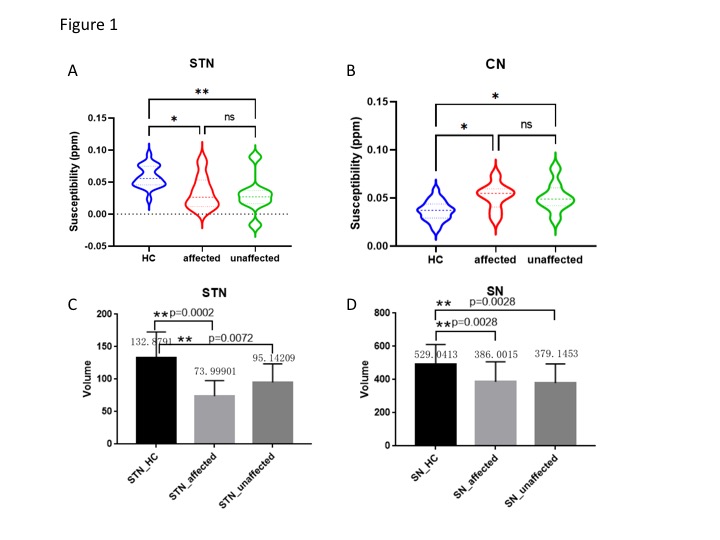Category: Parkinson's Disease: Genetics
Objective: PLA2G6 is the causative gene for autosomal recessive Dystonia-Parkinsonism (PARK14). The aim of this study was to explore the characteristics of iron deposition within the deep grey matter nuclei of PARK14 using Quantitative Susceptibility Mapping (QSM) which is now considered to be the only quantitative imaging technique of brain iron deposition.
Background: PLA2G6 is also the causative gene of neurodegeneration with brain iron accumulation-2B (NBIA-2B). Patients diagnosed as NBIA have been reported to show varying degrees of cerebral and cerebellar atrophy as well as basal ganglia iron deposition. But in PARK14, the characteristics of iron deposition and volume within the deep grey matter nuclei are not yet quantified.
Method: This study was HIPAA compliant and institutional review board approved. Seven patients with PLA2G6 mutations (mean age 29yr) and twenty age- and gender-matched healthy controls (mean age 29yr) underwent QSM were recruited in this study. Susceptibility maps were derived by inverting the filtered phase maps. Region of interest (ROI) in deep grey matter nuclei were manually drawn on all images, including head of caudate nucleus (CN), putamen (PUT), global pallidus (GP), subthalamus nucleus (STN), substantia nigra (SN) and red nucleus (RN). Susceptibility values and volumes of each ROI was calculated and analyzed.
Results: The STN showed significantly decreased susceptibility values in the PARK14 compared with the healthy controls (0.034 vs 0.058, P<0.05). While in CN, the PARK14 group had increased susceptibility values (0.052 vs 0.037, P<0.05). The volumes of the SN were significantly reduced in PARK14 (386.0015 vs 529.0413, P<0.05). So were the volumes of STN in PARK14 (73.99901 vs 132.8791, P<0.05) (See Fig.1). The differences in other regions were insignificant.
Conclusion: PARK14 patients showed obvious volume reduction in bilateral STN and SN, and higher magnetic susceptibility values in CN. But the magnetic susceptibility values in STN was lower in PARK14 compared to HCs. Consider the significant reduction of the volume of STN, the lower magnetic susceptibility values of STN may result from a more significant loss of neuronal cells. Our results indicate that supratentorial deep nucleus atrophy of STN and SN as well as iron deposition in CN may play a predominant role in the disease pathogenesis.
To cite this abstract in AMA style:
C. Chen, X. Liu, F. Liu, Y. Sun, J. Wang. Iron deposition and volume change of deep grey matter nuclei in PARK14 by Quantitative Susceptibility Mapping [abstract]. Mov Disord. 2023; 38 (suppl 1). https://www.mdsabstracts.org/abstract/iron-deposition-and-volume-change-of-deep-grey-matter-nuclei-in-park14-by-quantitative-susceptibility-mapping/. Accessed January 7, 2026.« Back to 2023 International Congress
MDS Abstracts - https://www.mdsabstracts.org/abstract/iron-deposition-and-volume-change-of-deep-grey-matter-nuclei-in-park14-by-quantitative-susceptibility-mapping/

